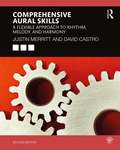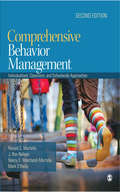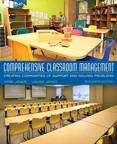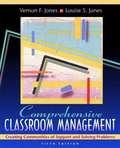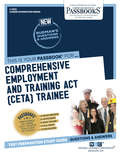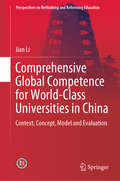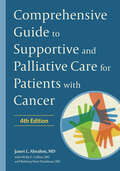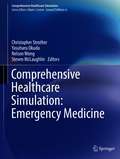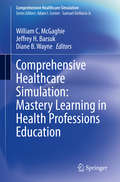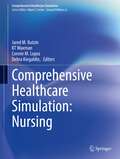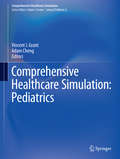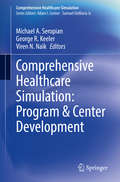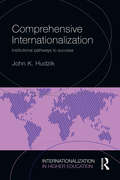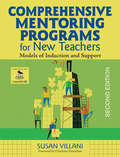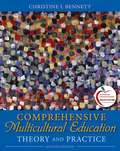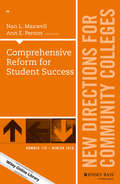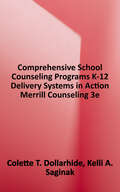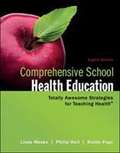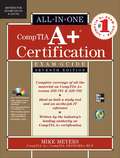- Table View
- List View
Comprehensive Aural Skills: A Flexible Approach to Rhythm, Melody, and Harmony
by David Castro Justin MerrittComprehensive Aural Skills is a complete suite of material for both performance and dictation, covering the wide range of sight singing and ear training skills required for undergraduate courses of study. It provides a series of instructional modules on rhythm, melody, and harmony, and blends musical examples from the common-practice repertory with original examples composed to specifically address particular skills and concepts. Each module includes material for classroom performance, self-directed study, and homework assignments. Features A complete suite of aural skills material: Comprehensive Aural Skills is a combined sight singing and ear training textbook, audio, and companion website package. Fully modular, customizable organization: Instructors can choose freely from the set of exercises in the book and supplemental material on the companion website to appropriately tailor the curriculum based on their students’ needs. Engaging and idiomatic musical examples: Examples are selected and composed specifically for the didactic context of an aural skills classroom. Dictation exercises for practice and assignment: Practice exercises include an answer key so students can work independently and receive immediate feedback, while homework assignments are given without a key. Audio examples for dictation: The website hosts live recordings of acoustic instruments performed by professional musicians for each dictation exercise and homework assignment. Supplemental Materials for Instructors: A wealth of material for class use and assignment can be found on the companion website. Teachers Guide: The guide includes answers for every homework assignment, brief commentary on each module’s content, tips for integrating written theory, and strategies on how to effectively teach new concepts and skills. The companion website for Comprehensive Aural Skills includes a wealth of additional examples in all areas of aural skills and at every level of difficulty represented in the text. Students have access to additional dictation examples with recordings and answer keys, allowing them to directly reinforce their classroom experience and practice dictation on their own time.
Comprehensive Aural Skills: A Flexible Approach to Rhythm, Melody, and Harmony
by David Castro Justin MerrittComprehensive Aural Skills is a complete suite of material for both performance and dictation, covering the wide range of sight singing and ear training skills required for undergraduate courses of study. It provides a series of instructional modules on rhythm, melody, and harmony, and blends musical examples from the common-practice repertory with original examples composed to specifically address particular skills and concepts. Each module includes material for classroom performance, self-directed study, and homework assignments. Features A complete suite of aural skills material: Comprehensive Aural Skills is a combined sight singing and ear training textbook, audio, and companion website package. Fully modular, customizable organization: Instructors can choose freely from the set of exercises in the book and supplemental material on the companion website to appropriately tailor the curriculum based on their students’ needs. Engaging and idiomatic musical examples: Examples are selected and composed specifically for the didactic context of an aural skills classroom. Dictation exercises for practice and assignment: Practice exercises include an answer key so students can work independently and receive immediate feedback, while homework assignments are given without a key. Audio examples for dictation: The website hosts live recordings of acoustic instruments performed by professional musicians for each dictation exercise and homework assignment. Supplemental Materials for Instructors: A wealth of material for class use and assignment can be found on the companion website. Teachers’ Guide: The guide includes answers for every homework assignment, brief commentary on each module’s content, tips for integrating written theory, and strategies on how to effectively teach new concepts and skills. This updated Second Edition includes Revised Rhythm module structure, now introducing foundational concepts more gradually Additional examples from the repertory in the Harmony and Melody modules New and improved recordings on the companion website
Comprehensive Behavior Management: Individualized, Classroom, and Schoolwide Approaches
by Nancy E. Marchand-Martella Ronald C. Martella J. Ron Nelson Mark O'ReillyComprehensive Behavior Management: Schoolwide, Classroom, and Individualized Approaches supports teachers in preventing management problems and responding to unwanted behavior when it occurs in classrooms. The text offers a comprehensive presentation of three levels of behavior management strategies: individual, classroom, and schoolwide, all three of which contribute to a positive learning environment. A social learning emphasis in which human behavior is viewed within an ecological framework is integrated throughout the text. Application of this information is supported by a range of pedagogical devices such as vignettes, examples, strategies, and activities to show teachers how to manage behavior effectively. The analysis and applications in this text cover both general education and special education strategies.
Comprehensive Classroom Management: Creating Communities Of Support And Solving Problems
by Vern Jones Louise JonesComprehensive Classroom Management is packed with practical advice and real-life examples to help teachers understand and apply the principles of classroom management in their own classroom situations. Comprehensive, based on the most current research, and supported through the examples of thousands of teachers already using these techniques, the book emphasizes creating classrooms where students feel safe because they know they are respected and supported by their teacher and peers—and where classroom behavior standards have been developed with and agreed upon by students. Through detailed case studies, examples, and descriptions of specific strategies, the book also examines instructional methods that support high rates of student engagement and methods for responding effectively to minor as well as serious and ongoing situations where student behavior disrupts the learning environment.The Eleventh Edition expands its emphasis on data-driven research-based approaches to classroom management, including a new focus on how brain research and trauma-sensitive classrooms that can informs our understanding of student learning and behavior. The Enhanced Pearson eText features interactive classroom simulations.
Comprehensive Classroom Management: Creating Communities of Support and Solving Problems
by Vernon Jones Louise JonesThis text for educators, administrators, and counselors investigates such influences on student behavior as interpersonal relationships in the class, the interaction between the school and the home, student motivation, and methods of instruction.
Comprehensive Employment and Training Act: Passbooks Study Guide (Career Examination Series)
by National Learning CorporationThe Comprehensive Employment & Training Act (CETA) Trainee Passbook® prepares you for your test by allowing you to take practice exams in the subjects you need to study. It provides hundreds of questions and answers in the areas that will likely be covered on your upcoming exam, including but not limited to: understanding and interpreting written material; preparing written material; understanding and interpreting tabular material; report writing; interpreting statistical data in graphs, charts and tables; reading comprehension; and other related areas.
Comprehensive Global Competence for World-Class Universities in China: Context, Concept, Model and Evaluation (Perspectives on Rethinking and Reforming Education)
by Jian LiThis book proposes the new concept of “comprehensive global competence” in order to explore how to advocate, cultivate, and implement global competence at China’s higher education institutions. The concept essentially refers to an organizational, cross-cultural capacity involving students, faculty members, administrators, and staff in a multidimensional learning domain that values, shapes, and promotes global competitiveness at higher education institutions. Unlike the other literature available, which has largely approached defining global competence it from four perspectives: an adaptation–change mode, an input–output mode, a willingness–tolerance mode, and a learning–competence mode, this book draws on the theoretical framework put forward in “Dimensions of Learning” (Marzano, 1992) in order to explain the meaning, implications, and justification of the concept of comprehensive global competence. Specifically, Marzano’s Dimensions of Learning Model offers a comprehensive research-oriented framework on learning cognition and the learning process. With the help of this resource, the book discusses in detail the conceptual, practical, and strategic aspects of creating comprehensive global competence.
Comprehensive Guide to Supportive and Palliative Care for Patients with Cancer
by Janet L. AbrahmLeading palliative care experts illustrate how you can improve both communication with cancer patients and their quality of life.For more than twenty years, this guide has been the go-to resource for busy practicing oncology and palliative care clinicians. This fourth edition, now titled Comprehensive Guide to Supportive and Palliative Care for Patients with Cancer, provides physicians, advanced practice clinicians, and patients and their families with detailed information and advice for alleviating the suffering of cancer patients and their loved ones. Drawing on the work of experts who have developed revolutionary approaches to symptom management and palliative care, as well as on lessons learned during her decades as a teacher and clinician, Dr. Janet L. Abrahm and her coauthors illustrate how to help patients and families understand their prognosis, communicate their care preferences, and minimize their distress.This edition reflects important updates in the field while addressing the informational needs of a broader market of health care providers, including social workers, psychologists, psychiatrists, bereavement counselors, and chaplains. This new edition features three new chapters—"Spiritual Care in Palliative Care," "Psychological Considerations," and "Bereavement"—as well as specific guidelines about • advance care planning at all phases of cancer• understanding complex family dynamics and communication challenges• partnering with interpreters in the care of patients and family members with limited English-language proficiency• special considerations to take into account for LGBTQ+ patients and their loved ones• caring for patients who have a serious mental illness along with a cancer diagnosis• nonpharmacologic management of pain and other symptoms associated with cancer or its treatmentThe book features self-reflective exercises that encourage readers to consider their own biases before having discussions with patients and family members, as well as numerous patient stories that illustrate the techniques and insights clinicians can use to provide holistic, multidimensional care for a diverse cancer patient population.
Comprehensive Healthcare Simulation: Emergency Medicine (Comprehensive Healthcare Simulation)
by Yasuharu Okuda Steven McLaughlin Christopher Strother Nelson WongThis is a practical guide to the use of simulation in emergency medicine training and evaluation. It covers scenario building, debriefing, and feedback, and it discusses the use of simulation for different purposes, including education, crisis resource management and interdisciplinary team training. Divided into five sections, the book begins with the historical foundations of emergency medicine, as well as education and learning theory. In order to effectively relay different simulation modalities and technologies, subsequent chapters feature an extensive number of practical scenarios to allow readers to build a curriculum. These simulations include pediatric emergency medicine, trauma, disaster medicine, and ultrasound. Chapters are also organized to meet the needs of readers who are in different stages of their education, ranging from undergraduate students to medical directors. The book then concludes with a discussion on the future and projected developments of simulation training. Comprehensive Healthcare Simulation: Emergency Medicine is an invaluable resource for a variety of learners, from medical students, residents, and practicing emergency physicians to emergency medical technicians, and health-related professionals.
Comprehensive Healthcare Simulation: Implementing Best Practices in Standardized Patient Methodology (Comprehensive Healthcare Simulation)
by Gayle Gliva-McConvey Catherine F. Nicholas Lou ClarkThis book brings to life best practices of Human Simulation; maximizing the Standardized Patient (SP) methodology that has played a major role in health professions learning and assessment since the 1960s. Each chapter reflects the Association of SP Educators Standards of Best Practices (SOBPs) and provides guidance for implementation. Multiple insights are offered through embedded interviews with international experts to provide examples illustrating successful strategies.The Human Simulation Continuum Model, a practical and theoretical framework, is introduced to guide educators in decision-making processes associated with the full range of human simulation. The Continuum Model spans improvisations, structured role-play, embedded participants, and simulated-standardized patients. This book also provides the full “how-to” for SP methodology covering topics including; case/scenario development, creating training material, training techniques for case portrayal, training communication and feedback skills, GTA/MUTA/PTA training, SP program administration and professional development for SP Educators. A pragmatic, user-friendly addition to the Comprehensive Healthcare Simulation series, Implementing Best Practices in Standardized Patient Methodology is the first book framed by the ASPE SOBPs, embracing best practices in human simulation and marshaling the vast expertise of a myriad of SP Educators.
Comprehensive Healthcare Simulation: Mastery Learning in Health Professions Education (Comprehensive Healthcare Simulation)
by William C. McGaghie Jeffrey H. Barsuk Diane B. WayneThis book presents the parameters of Mastery Learning (ML), an especially stringent variety of competency-based education that guides students to acquire essential knowledge and skill, measured rigorously against a minimum passing standard (MPS). As both a scholarly resource and a teaching tool, this is a “how to” book that serves as a resource for a wide variety of health professions educators.A seminal source of information and practical advice about ML, this book divided into five parts: Clinical Education in the Health Professions, The Mastery Learning Model, Mastery Learning in Action, Transfer of Training from Mastery Learning and The Road Ahead. Complete with high-quality images and tables, chapters take an in-depth look into ML principles and practices across the health professions. Specific educational content instructs readers on how to build and present ML curricula, evaluate short and long-run results, conduct learner debriefing and give powerful feedback, set learner achievement standards, and prepare faculty for new educational roles.An invaluable addition to the Comprehensive Healthcare Simulation Series, Mastery Learning in Health Professions Education is written and edited by leaders in the field for practicing clinicians in a variety of health professions.
Comprehensive Healthcare Simulation: Nursing (Comprehensive Healthcare Simulation)
by Jared M. Kutzin Kt Waxman Connie M. Lopez Debra KiegaldieSimulation-based education is a rapidly expanding field. The use of simulation was pioneered in anesthesiology and nursing over 50 years ago. However, recent advances have allowed simulation to become commonplace in many different educational environments. These environments include undergraduate nursing education, graduate nursing education, and post-graduate clinical education.This book provides an in-depth review of the common simulation techniques used in each setting and then dives deeper into each of the practice areas that nurses use for simulation. The book offers an overview for novice simulation users as well as a resource for simulation users looking to expand into other uses.Capturing the latest advances, this book brings a comprehensive review of gradate and post-graduate clinical simulation together in a single resource.
Comprehensive Healthcare Simulation: Pediatrics (Comprehensive Healthcare Simulation #0)
by Vincent J. Grant Adam ChengThis is a practical guide to the use of simulation in pediatric training and evaluation, including all subspecialty areas. It covers scenario building, debriefing and feedback, and it discusses the use of simulation for different purposes: education, crisis resource management and interdisciplinary team training, competency assessment, patient safety and systems integration. Readers are introduced to the different simulation modalities and technologies and guided on the use of simulation with a variety of learners, including medical students, residents, practicing pediatricians, and health-related professionals. Separate chapters on each pediatric subspecialty provide practical advice and strategies to allow readers to integrate simulation into existing curriculum. Pediatric subspecialties covered include: General Pediatrics, Pediatric Emergency Medicine and Trauma, Neonatology, Pediatric Critical Care Medicine, Transport Medicine, Pediatric Anesthesia, and Pediatric Surgery amongst many others. Comprehensive Healthcare Simulation PEDIATRICS Edition is a volume in the series, Comprehensive Healthcare Simulation. The series is designed to complement Levine et al. , eds. , The Comprehensive Textbook of Healthcare Simulation by providing short, focused volumes on the use of simulation in a single specialty or on a specific simulation topic, and emphasizing practical considerations and guidance.
Comprehensive Healthcare Simulation: Program & Center Development (Comprehensive Healthcare Simulation)
by Michael A. Seropian George R. Keeler Viren N. NaikThink - Plan - BuyThis is the first complete guide for creating a sustainable healthcare simulation program/center. It is created by experts in the field that are on the front lines of this emerging field. It is intended and written with all professions in mind, and should be a resource for all, be they healthcare educators, administrators, or executives. It covers specific elements of the entire process, from concept to execution, and identifies key decision points along the way. The book is organized around fundamental considerations in center and program development including governance, structural/facility and curricular design, business planning, to establishing policies and procedures. Chapters analyze the fundamental aspects of planning, such as budgeting, revenue streams, and philanthropy as well as the inclusion of educational resources within such programs.Comprehensive Healthcare Simulation: Program and Center Development is an invaluable addition to the Comprehensive Healthcare Simulation series, and features an authoritative authorship of experts in the field.
Comprehensive Internationalization: Institutional pathways to success (Internationalization in Higher Education Series)
by John K. HudzikThis book is a timely insight into the internationalization of higher education institutions. The internationalization of higher education is a global phenomenon, but with substantial variation in how it is made operational in individual institutions. Comprehensive Internationalization focuses on desirable practices in institutions and their actual approaches to implement a more integrated, strategic, or comprehensive global engagement across their core missions: teaching, research, and service. Part I of the book investigates a wide range of issues governing the internationalization of institutions: Outlining the origins, meaning and evolution toward more strategic and comprehensive forms of internationalization; building an understanding of the meanings of comprehensive internationalization, as well as common aspirations, when linked to different types of institutions; understanding the rationales and motivations for internationalization and intended results; creating an institutional vision and culture to support comprehensive internationalization; and implementing key strategies for successful internationalization in terms of practical actions and programs and results, including identifying and ameliorating barriers, engaging organizational change, assessing outcomes, and obtaining resources. Part II of the book offers case stories from institutions across the globe which describe varying pathways toward more comprehensive internationalization. Institutions were chosen to reflect the diversity of higher education and approaches to internationalization. An analysis of the cases uncovers similarities and differences, as well as common lessons to be learned. With contributions from mainland Europe, Australia, the USA, the UK, Latin America, Singapore and South Africa, the global application of the book is unparalleled. Comprehensive Internationalization will be of vital interest to a wide variety of higher education institutional leaders and managers as they address the problems and solutions for institutional internationalization available to them in a rapidly changing educational world and a 21st Century global environment.
Comprehensive Mentoring Programs for New Teachers: Models of Induction and Support
by Susan VillaniThis updated edition presents 18 successful real-world programs, 5 factors for developing a comprehensive mentoring initiative, and new material for mentoring special education, math, and science teachers.
Comprehensive Multicultural Education: Theory and Practice (7th Edition)
by Christine I. BennettWritten for new teachers, this guide to multicultural education presents interdisciplinary content through primary source material and vignettes of actual teachers and students. Providing an in-depth focus in key areas as well as a broad overview, Christine Bennett aims to help prepare teachers who are informed and caring advocates for students from all cultural, racial, socioeconomic, linguistic, and national backgrounds.
Comprehensive Reform for Student Success: New Directions for Community Colleges, Number 176 (J-B CC Single Issue Community Colleges)
by Ann E. Person Nan L. MaxwellCommunity colleges face pressure to “do more with less” that have prompted many college leaders to consider fundamental changes to the ways they have typically done business. Because piecemeal solutions have not often been effective or efficient, colleges are moving far beyond discreet “programs” or “interventions,” and are attempting to implement comprehensive reform efforts. This volume conceptualizes comprehensive reform as being marked by: a focus on student success; a theory of change that ties programmatic components together in an intentional and cohesive package, implemented at multiple levels throughout the college and touching the majority of students; and a culture of evidence that uses data to continuously assess programs and processes against student success. Presenting original analyses that describe the rationale for comprehensive reform, this volume examines the challenges involved in implementing, evaluating, and sustaining those efforts. This is the 176th volume of this Jossey-Bass quarterly report series. Essential to the professional libraries of presidents, vice presidents, deans, and other leaders in today's open-door institutions, New Directions for Community Colleges provides expert guidance in meeting the challenges of their distinctive and expanding educational mission.
Comprehensive Regional Reform: The Transformation and Breakthrough in China’s Educational Reform (Research in Chinese Education)
by Xiaofei Wang Guihua LiuThis book ambitiously presents the current directions and goals of the Chinese idea of modernization in education. Searching for a neutral way to understand educational reform and policy-making in the midst of many different theories in the field, the authors combine the theories of ecology, regional studies, and educational philosophy to focus on the hot topics relating to the current problems in Chinese education. In addition to the theory of education, it offers an interdisciplinary approach to educational policy and administration, including perspectives from history, evaluation and (big) data processing, modernization, planning-making, curriculum and teaching, element analysis etc. within or beyond the limits of education.This book is a valuable resource for policy-makers and administrators as well as teachers and students majoring in education or related fields. It is also beneficial to those interested in interdisciplinary approaches to educational theory studies and regional studies in education, and practitioners in schools and higher education institutes as well as anyone wanting insights into Chinese education from the perspective of regional studies.
Comprehensive School Counseling Programs: K-12 Delivery Systems in Action
by Colette T. Dollarhide Kelli A. SaginakAn in-depth look at all aspects of creating and managing a comprehensive school counseling program, with a focus on designing systemic programs to serve all students. Accessible and inclusive, this comprehensive guide to K-12 school counseling explores delivery systems and the practical tools professional school counselors need to design, implement, manage, and evaluate comprehensive, developmentally appropriate school counseling programs for all students. Starting from the perspective of "What is a school?" it presents and updates all of the elements of a comprehensive school counseling program, including the holistic, balanced, preventive, and reflective elements, and those integrated with the academic agenda. Aligned with the most current ASCA National Model, ASCA Competencies, and new 2016 CACREP Standards, Comprehensive School Counseling Programs underline the professional context of school counseling in the real world of public education. The updated, revised chapters of this new edition written by contemporary experts in the field of school counseling.
Comprehensive School Health Education
by Randy M. Page Linda Meeks Philip HeitThis book has been the leading teacher resource book used to prepare future and current elementary school, middle school, and secondary school teachers to teach health since the publication of the first edition in 1991. It also has been the most widely used teacher resource book selected by state departments of education, school districts, and departments of health for inservice and train-the-trainers programs. As you read about its contents, you will learn why teachers who purchase it find it the most teacher-friendly resource book available for health education.
Comprehensive School Health Education
by Linda Meeks Philip Heit Randy Page Phillip WardComprehensive School Health Education, provides everything needed to teach health in grades K-12. The authors continue to offer their dynamic and empowering approach to teaching health skills. This book includes lesson plans, online and app-based tools for assessment, and Totally Awesome Teaching Strategies masters - a curriculum tool aligned with National Health Education Standards and CDC guidelines for health education. This edition also introduces the Whole School, Whole Community, Whole Child (WSCC) model from the CDC and ASCD
Comptia A+ Certification: All-in-One Exam Guide (7th Edition)
by Michael MeyersGet complete coverage of the latest release of the CompTIA A+ exams inside this fully revised and updated resource. Written by the leading authority on CompTIA A+ certification and training, this expert guide covers CompTIA A+ exams 220-701 and 220-702. You'll find learning objectives at the beginning of each chapter, exam tips, practice exam questions, in-depth explanations, and more than 1,000 photographs and illustrations. Designed to help you pass the CompTIA A+ exams with ease, this definitive volume also serves as an essential on-the-job IT reference. Covers all exam objectives, including how to: Work with CPUs, RAM, motherboards, power supplies, and other PC components Install, partition, and format hard drives Install, upgrade, and troubleshoot Windows 2000, Windows XP, and Windows Vista Troubleshoot PCs and implement security measures Install video and multimedia cards Work with portable PCs, PDAs, smartphones, and wireless technologies Manage printers and connect to networks and the Internet Understand safety and environmental issues Establish good communication skills and adhere to privacy policies The CD-ROM features: Practice exams for 701 & 702 600+ chapter review questions New video introduction to CompTIA A+ One-hour video training segment Mike's favorite PC tools and utilities Searchable e-book Mike Meyers, CompTIA A+, CompTIA Network+, MCP, is the industry's leading authority on CompTIA A+ certification and training. He is the president and founder of Total Seminars, LLC, a major provider of PC and network repair seminars for thousands of organizations throughout the world, and a member of CompTIA.
Comptia Security+ All-in-one Exam Guide, Fifth Edition (exam Sy0-501)
by Greg White Dwayne Williams Chuck Cothren Roger L. Davis Wm. Arthur Conklin<P>This fully updated study guide covers every topic on the current version of the CompTIA Security+ exam <P>Take the latest version of the CompTIA Security+ exam with complete confidence using the detailed information contained in this highly effective self-study system. Written by a team of leading information security experts, this authoritative guide addresses the skills required for securing a network and managing risk and enables you to become CompTIA Security+ certified. <P>CompTIA Security+ All-in-One Exam Guide, Fifth Edition (Exam SY0-501) covers all exam domains and features 200 accurate practice questions. To aid in study, the book features learning objectives at the beginning of each chapter, exam tips, practice exam questions, and in-depth explanations. <P> All questions mirror those on the live test in style, format, and difficulty. Beyond fully preparing you for the challenging SY0-501 exam, the book also serves as a valuable on-the-job reference for IT professionals. <br>• Provides 100% coverage of every objective on exam SY0-501 <br>• Electronic content includes 200 practice questions and a secured book PDF <br>• Written by a team of experienced IT security academics
Comptia Security+ Get Certified Get Ahead: Sy0-501 Study Guide
by Darril GibsonThe CompTIA Security+ Get Certified Get Ahead SY0-501 Study Guide is an update to the top-selling SY0-201, SY0-301, and SY0-401 study guides, which have helped thousands of readers pass the exam the first time they took it. It covers all of the SY0-501 objectives and includes the same elements readers raved about in the previous two versions. Each of the eleven chapters presents topics in an easy to understand manner and includes real-world examples of security principles in action. The author uses many of the same analogies and explanations he's honed in the classroom that have helped hundreds of students master the Security+ content. You'll understand the important and relevant security topics for the Security+ exam, without being overloaded with unnecessary details. Additionally, each chapter includes a comprehensive review section to help you focus on what's important. Over 300 realistic practice test questions with in-depth explanations will help you test your comprehension and readiness for the exam. The book includes a 75 question pre-test, a 75 question post-test, and practice test questions at the end of every chapter. Each practice test question includes a detailed explanation to help you understand the content and the reasoning behind the question. You'll also have access to free online resources including labs and additional practice test questions. Using all of these resources, you'll be ready to take and pass the exam the first time you take it. If you plan to pursue any of the advanced security certifications, this guide will also help you lay a solid foundation of security knowledge. Learn this material, and you'll be a step ahead for other exams. This SY0-501 study guide is for any IT or security professional interested in advancing in their field, and a must read for anyone striving to master the basics of IT systems security. The author supplements the book with blog posts here: http: //blogs.getcertifiedgetahead.com/. This page provides a full listing of mobile device apps from the author: http: //learnzapp.com/partners/darrilgibson/.

